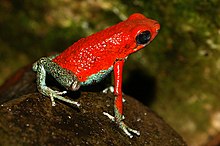Oophaga granulifera
The granular poison frog, granular poison arrow frog, or granular poison arrow frog (Oophaga granulifera) is a frog. It lives in Costa Rica on the Pacific side (west side) of the country. Scientists think it could live in Panama too.[2][3][1]
| Oophaga granulifera | |
|---|---|

| |
| Scientific classification | |
| Domain: | Eukaryota |
| Kingdom: | Animalia |
| Phylum: | Chordata |
| Class: | Amphibia |
| Order: | Anura |
| Family: | Dendrobatidae |
| Genus: | Oophaga |
| Species: | O. granulifera
|
| Binomial name | |
| Oophaga granulifera (Taylor, 1958)
| |
| Synonyms[2] | |
| |
Appearance
changeMale and female adult frogs are 18-22 mm long from nose to rear end. The skin of the frog's back and the tops of all four legs is bright red or bright orange in color. The belly and other parts of the legs are green or blue-green in color.[3]
Home
changeThis frog lives on the ground in forests where there is water in the air. People have also seen it in forests that have been cut down and are growing back. They always live near small streams. This frog moves around during the day.[3] People have seen this frog between 10 and 100 meters above sea level.[2]
Young
changeThe male frog calls for the female frog, and the female frog comes to him. Then the male frog leads the female frog to a good place to lay eggs. The female frog lays eggs on dead leaves that are not on the ground. The leaves may be on rocks or stuck in trees. Male frogs stay to watch the eggs. Sometimes they stop the eggs from drying out by putting liquid from their bladders on them. The female frog lays more groups of eggs until the first one hatches. After the eggs hatch, she carries tadpoles to bromeliad plants that have water in their leaves in small pools. She puts the tadpoles in the water one at a time. Sometimes scientists see two tadpoles together but never more than two. The female frog lays eggs that will not hatch for the tadpoles to eat.[3]
Wild tadpoles become frogs after about 80 days. When humans raise the tadpoles and feed them chicken egg yolk, they become frogs after 200 days. Sometimes they only become frogs if they get a chemical too.[3]
Danger
changeScientists believe this frog is in some danger of dying out because it lives in a small place and because people cut down forests to make farms for palm oil, banana, and pineapples. Chemicals meant to kill pests may also kill this frog. People also catch these frogs to sell as pets.[1]
This frog's home has some protected parks in it: Reserva Forestal Golfo Dulce, Refugio de Vida Silvestre Golfito, and Refugio de Vida Silvestre Boracayán.[1]
References
change- ↑ 1.0 1.1 1.2 1.3 IUCN SSC Amphibian Specialist Group (2020). "Diablito: Oophaga granulifera". IUCN Red List of Threatened Species. 2020: e.T55186A3025447. doi:10.2305/IUCN.UK.2020-3.RLTS.T55186A3025447.en. Retrieved June 4, 2024.
- ↑ 2.0 2.1 2.2 Frost, Darrel R. "Oophaga granulifera (Taylor, 1958)". Amphibian Species of the World, an Online Reference. Version 6.0. American Museum of Natural History, New York. Retrieved June 4, 2024.
- ↑ 3.0 3.1 3.2 3.3 3.4 Kellie Whittaker; Ketti Augusztiny (December 2, 2004). Kellie Whittaker; Brent Nguyen; Michelle S. Koo (eds.). "Oophaga granulifera (Taylor, 1958)". AmphibiaWeb. University of California, Berkeley. Retrieved June 4, 2024.
